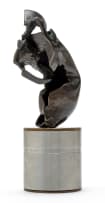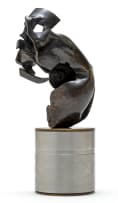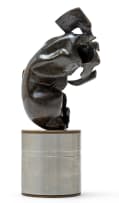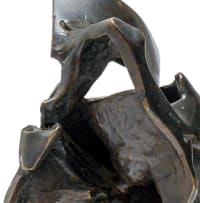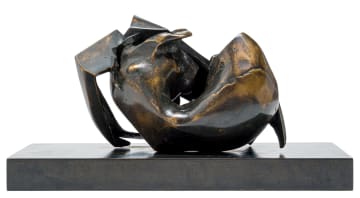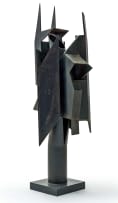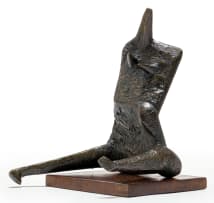Johannesburg Auction Week
Live Virtual Auction, 16 - 17 May 2022
Surrealism
About this Item
signed with the artist's initials and numbered 2/2
Notes
Conceptually, the Skull series is concerned with the human condition in a broad sense and with the tragic nature of man/woman's destiny. There is not one work in the series which does not take on the character of either the whole body or parts of a body; the viewer can discern backs and heads, elements which hook and gauge. Tears, cracks, and lacerations characterise these skulls repeatedly. The shield-like forms symbolising ineffectual defence are invariably dented and torn. The skulls, in their context of racks, grillers and tumbling structures, set up an interaction between solid and void that heightens the sense of emotional tension and conflict.'1
'Bearing in mind that the skull, in alchemical terms, is the vessel of transmutation, the crucible in which the 'base material' transforms into the wholeness of the self, it seems clear that Coetzee is indeed referring to the skull as symbol of the self: that which unites the opposites and transcends them. This notion is reinforced by his emphasis on those qualities (bigger, broader, wider, deeper, higher) which are transpersonal in nature, and supersede the individual ego. He elaborates: "The human head, which is built around the skull, is seen as the seat of all human faculties, the finest as well as the most wicked. The centre of man's talent, the centre of man's achievement. Yet, when stripped of its appendages, the skull is a symbol of death, destruction, a symbol of danger. Here is a contradiction. Why? It becomes diametrically opposed, the exact opposite pole of what it is in life."
Here, interestingly, we see the skull symbol as containing the positive and negative poles of the central archetype - containing not so much in the sense of 'including', but in the sense of holding together, uniting hence, indeed, a vessel. Coetzee explains: "This is why the skulls became torsos, bodies, this is why they became foetuses. The curves are female, foetal, they're rounded, they're soft. The lacerations are interruptions into a harmonious flow. This emphasises the vulnerability of an already distorted form. Distorted from its contained, globelike form. Twisted, dented, pushed, and then cracked. Later on they started carrying shields, attempting to protect. But it is not successful. In fact, the whole thing is moving through a crucible".'2
1. Neels Coetzee (1985) The Skull: Formal and Iconographical Sculptural Derivations, unpublished Master's dissertation, University of the Witwatersrand, Johannesburg, page 40.
2. Graham Saayman (1990) 'Images in Bronze: A Commentary on the Sculpture of Neels Coetzee' in Graham Saayman (ed) Modern South Africa in Search of a Soul: Jungian Perspectives on the Wilderness Within, Boston: Sigo Press, page 242.
Provenance
Inherited from the artist's estate.
Exhibited
Circa, Johannesburg, Neels Coetzee: Crucible, 3 to 26 September 2015.
Literature
Koulla Xinisteris (2015) Neels Coetzee: Crucible, exhibition catalogue, Johannesburg: Everard Read, illustrated in colour on page !!

